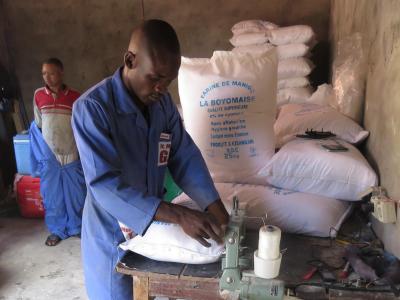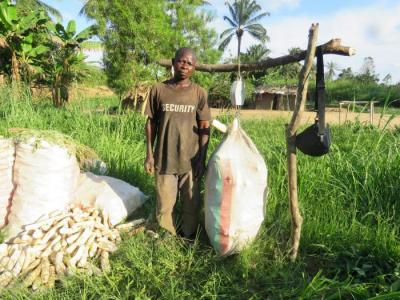- Accueil
- ENVIRONNEMENT ET BIODIVERSITE
- Agri durable
- La Boyomaise, a High-Quality Cassava Flour by Minofacs
La Boyomaise, a High-Quality Cassava Flour by Minofacs
KISANGANI - For nearly three years now, La Boyomaise is increasingly consumed by more and more people of Kisangani. LB is a packaged dry cassava flour produced by Minofacs (Minoterie de la Faculté des Sciences de l'Université de Kisangani). Processing flour is one of the activities carried on over four cities by VLIR – Sustainable agriculture project (VLIR-SA) in the DRC's North-Eastern Basin where stand Kisangani and its surroundings countryside, Bafawsende, 262 km, Nyanya, 245 km, and Mambasa, 520 km).
by Jean Fundi Kiparamoto, green journalist + 243 840 491 922 (WhatsApp + Mobile) / + 243 827 048 699 (Mobile) Email journalkaribu@gmail.com
Consumers answering to Journal Karibu web site unanimouslysay, "It's a lump-free, aromatic, and easily digestible fufu (do pronounce foufou) we've ever eaten". Workers from the University of Kisangani, High Schools and individuals alike are among customers of Minofacs. For about a year, the family of Tambwe, Senior Lecturer at ISEA Bengamisa (Institut Supérieur des Sciences Agronomiques) and collaborator at CSB (Centre de SurveillAnce de la Surveillance), pays for either the sack of 10 kg or that of 25 kg. "Ready-to-be-cooked and weighing out what it's mentioned on. La Boyomaise has saved my spouse the need to buy dried cassava, to then peel it to have it ground up by a rather unsavoury miller", he says. As reported by Jean-Trésor Kwembe, Bussiness Associate to Minofacs, "Our customers are fond of LB due to its nice taste, and especially the way it's packaged in unopened sacks suitable for preventing the flour from infestation by pest insects".
Indeed, things are done half manually. The process of producing LB consists of a series of steps called cassava value chain of which scientists say, "From harvesting to dish". Cassava tuberous roots, after being pulled out from the ground, are immediately peeled and brought to Kisangani. Then, roots follow more than one other step: deep cleansing with drinkable water, sliced in very small parts by a slicing machine, small parts are stored in permeable bags, and are wet for three days. Freshly harvested and peeled roots are stored 1-3 days by completely submerging in water. Wet sacks are stored in the hand-operating press to be freed of water starch. Before being ground up, small parts are sun-dried within one, two or three days depending upon how the sun shines. By contrast, the traditional wetting technique takes place in a backwater or small ponds dug by the river. "Which on many fronts threatens consumers' health", Pr Didy Onautshu, Local Coordinator of VLIR-SA, says.
All the countries in Central Africa (Angola, Cameroon, Gabon, DRC, Congo Sao Tomé-et-Principe and Tchad) are practicing traditional wetting for generations. But, thanks to improved wetting technique and thingummies offered by IITA (International Institute of Tropical Agriculture), Minofacs can produce 460 kg of flour from a ton of raw cassava containing almost, "Zero % of cyanide, zero % of aflatoxin and less starch", Local Coordinator concludes. La Boyomaise is instant flour destined to fufu cooking. Like plantain, maize, and rice, fufu is one of the staple foods in most cities and villages in the DRC's North-Eastern Basin.
Non-swidden agriculture, less work more benefit
In the North-Eastern Basin, there are a few numbers of non-slash-and-burn pioneers, one of whom lives at the Northwestern surroundings of Kisangani. Forty years old and father of eight children, Willy Kamango is the one who supplies all of the cassava Minofacs needs this year for use of making flour once a week. Like many other concerns, he had been practicing slash-and-burn farming since he was sixteen. As for him, he did it until before 2015 the time at which FAO (Food Agriculture Organization) and IITA came and begun teaching them the importance of improved cassava varieties and the long-lasting agriculture. His two first farms date back to 2015, that of 1.5 ha 12 km, and that of 2.5 ha 16 km away from Kisangani.
Joint Outreach to Advocate Sustainable Agriculture
Rural community's members owe the new cultural practices to the joint action of NGOs. Most of the farmers in the Basin are still practicing slash-and-burn cultivation even though it leads to a decrease in soil fertility, which leads them to move away in search of new healthy and fertile soil. Behind them, "The fallow period can spread between two and seven years", a farmer says. During the fallow, some farmers' families leave their village to settle either in other villages or set up on the one standing by new farms.
However, the joint action from FAO (Food Agricultural Organization), IITA, VLIR-SA, and Caritas Congo altogether is bringing some changes. FAO and IITA have popularized more than one variety of cassava, plants deseases-proof, known as Fao, Obama 1 and 2. IITA got an electrical slicing machine and a hand-operated press made. VLIR-SA, in association with Caritas Congo, is still going on promoting both the long-lasting cultivation, the outreach of healthy cassava stems, and the consumption of High-Quality Cassava Flour (HQCF).
Peelings are then left in place to contribute to making hummus, a kind of green manure while waiting for the land to be prepared before the next crop. "As can be seen, non-slash-and-burn agriculture allows small farmers to work less and increase their income", Pr Onautshu concludes.
Since last May, harvesting the one-third of the first one has yielded around 500$. "Just enough to pay school fees for kids and put some money aside to ensure my family welfare", Kamango says.
In 2015, a radio magazine, Sur la Voie du Progrès, was realized on Radio Flambeau de l'Orient, and presented by Jean Fundi K. The flour was called Fufu Becaro.
As far as he could remember, a similar farm having taken room on a burnt area of 1.5 ha could yield five hundred thousand francs congolais (around 300$) as a whole. In contrast, by the end of the next harvesting of the second farm in September 2019, Kamango would gain around four thousand dollars.
What is more, non-slash-and-burn cultivation results in many more advantages. To those who are scared considering slash-and-burn cultivation as a headache, Kamango replies, standing among a group of small farmers, "The bulk of the work ends at the very start, but next times require less effort. I can also reuse the same farm several times from one year to another". For him and other witnesses, the improved variety of cassava Obama is the best because a cluster bears up to eighteen tuberous while local varieties cannot exceed eight tuberous.
Also, on the second farm, the crop of cassava is associated with that of peanuts and tomatoes. Moreover, custom-made sale saves him to have cassava spoilt underground or attacked by rodents. Twice a week, Kamango can supply cassava to townspeople, of whom Pr Onautshu remains the great one. He hires women and young people, the formers of whom deal which peeling and the latter with carrying peeled cassava on the road that stands eight minutes from the farm.
Pr Onautshu remembers the first day training and popularization have taken place, "Training has been carried on through two farmer field schools, standing close to one another". The harvest occurred early in the first farm. The improved cassava variety came to maturity eight months later providing big tuberous roots while the local varieties could have been harvested a year later for some and fourteen months later for others.
Despite some slight progress, farmers are still facing risks, which lead to only short-term returns. Although, there are nine months rains out of a year, and suitable soil for planting more than one varieties of cassava, rural communities still have to understand that their survival and that of their progeny depends upon not only such better conditions but also the way they might negotiate the long-lasting agriculture. About that, there is a need to reinforce popularization and training during which Kamango may serve as a pattern to many of them they give up slash-and-burn cultivation.
In the meantime, researchers funded by VLIR-UOS (Professors Benoît Dhed'a, Hypolite Nshimba, and Didy Onautshu and their team) are trying to find out substances based on medicinal plants. The purpose is to strengthen plants resistance to diseases. Professor Onautshu is warning, "On the one hand, small farmers had better take ownership of new cultivation practices. On the other hand, sustainable agriculture without plants sanitation is a nearly zero effort".
Pr Onautshu Unveils Plan to Forthcoming Innovations
The plan focuses on supplying more cassava to Minofacs and meeting the HQCF rush of orders. "Which is why VLIR-SA should purchase further processing equipment not only linked to the cassava value chain, but also to that of plantain, maize, and soja", Pr Onautshu unveils. He plans to be in a position to satisfy consumers' and farmers' requirements at the same time.
On the one hand, encouraging farmers so that market demands undoubtedly requires them to increase their cassava yield per hectare. Minofacs will continue buying cassava from farmers who for generations devoted their lives to feeding urban populations. On the other hand, to meet the rush of orders from consumers, Pr Onautshu intends to buy more processing equipment not only to further improve the cassava value chain, but also that of plantain, maize, and soya.
In particular, there is a need to purchase a miller for each kind of product such as an electric dryer to be installed in a hall, which has just been renovated, to fasten the drying and then come to zero % of cyanide and aflatoxin. That is, tools, equipment, and other materials that are useful to set the quality standard. Minofacs would be in a position to provide plantain flor, maize flour, baking flour, thrice the 460 km of HQCF per week, starch, and so on...
Dealing with plantain, mushroom, and cassava, VLIR-Sustainable agriculture funded by VLIR-UOS is a project with participants from the University of Kisangani and rural communities across the DRC's North-Eastern Basin where stands Kisangani and its surrounding countryside, Bafwasende, Nyanya, and Mambasa.
La cérémonie de fin programme avait eu lieu les 6 et 7 avril 2022 sur le campus de la Faculté des Sciences de l'UNIKIS/RDC
Fin programme VLIR-UOS (UHASSELT et UNIKIS) - extraits d'allocutions et interviews
Date de dernière mise à jour : jeudi, 18 janvier 2024


